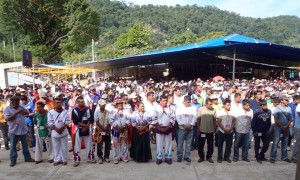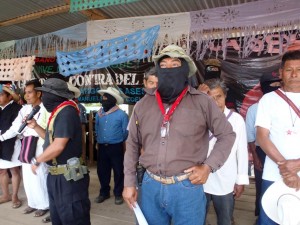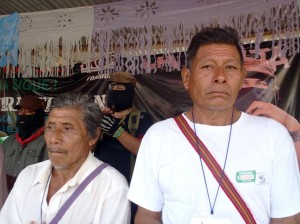 Representatives of Mexico’s indigenous peoples have issued a new declaration and announced upcoming mobilizations to further their cause. Unveiled on August 9, the UN-celebrated International Day of the World’s Indigenous People, the declaration followed a week-long meeting between the Zapatista National Liberation Army (EZLN) and National Indigenous Congress (CNI) in the southern Mexican border state of Chiapas.
Representatives of Mexico’s indigenous peoples have issued a new declaration and announced upcoming mobilizations to further their cause. Unveiled on August 9, the UN-celebrated International Day of the World’s Indigenous People, the declaration followed a week-long meeting between the Zapatista National Liberation Army (EZLN) and National Indigenous Congress (CNI) in the southern Mexican border state of Chiapas.
Detailing 29 points, the Declaration of the Plundering of Our Peoples blasted the Pena Nieto Administration, big corporations and capitalism in general for threatening the culture and survival of indigenous peoples.
Couched in historical terms that reference the sacrifices made by indigenous people and small farmers for a Mexico that was denied to them, the statement was read by Venustiano Vazquez Navarette, indigenous resident of Tepotzlan, Morelos, in the Zapatista base community of La Realidad.
It read in part: “Capitalism has grown from plunder and exploitation since the beginning. Invasion and plunder are the words that best describe what is called the conquest of America, plunder and robbery of our lands, our territories, our knowledge, our culture. Plunder accompanied by war, massacres, jail, death and more death…”
The declaration accuses “neoliberal capitalists” together with the U.S.-advised Mexican government of opting for military and paramilitary methods in stripping indigenous Mexicans of their patrimony.
“We say to the powerful, to the companies and to the bad governments, headed by the criminal chief of the paramilitaries, (President) Enrique Pena Nieto, that we do not surrender, we do not sell out and we do not give up,” the statement vows.
More than 1,600 people attended the gathering in the Zapatista base community of La Realidad, including 1,300 Mayan Zapatista supporters from Chiapas. Coming from all corners of the nation, the CNI delegates represented more than two dozen indigenous groups, among them the Raramuri, Huichol, Purepecha, Mixteco, and Tzotzil Maya.
 In a competing event of sorts President Enrique Pena Nieto, who was on his way back to Mexico from a trip to Colombia, participated in an August 8 ceremony commemorating the International Day of the World’s Indigenous People in the Mayan town of San Juan Chamula, Chiapas,
In a competing event of sorts President Enrique Pena Nieto, who was on his way back to Mexico from a trip to Colombia, participated in an August 8 ceremony commemorating the International Day of the World’s Indigenous People in the Mayan town of San Juan Chamula, Chiapas,
“My government is an ally of the indigenous peoples, and respects its traditions,” Pena Nieto insisted. In his remarks, Pena Nieto, who was attired in traditional Chamulan dress for the occasion, insisted that his administration’s education, telecommunications, tax and energy reforms would benefit indigenous Mexico.
As an example of favorable policies, the Mexican president cited an agreement between the official National Commission for the Development of Indigenous Peoples (CDI) and the Federal Electricity Commission to bring power to 150 communities. Attended by representatives of the nation’s 68 indigenous groups, the San Juan Chamula event featured a speech by Chiapas Governor Manuel Velasco who recognized the historical importance of indigenous movements including the 1994 Zapatista uprising that shook Mexico.
“Today the indigenous peoples are ready to accompany the transformation,” Velasco said.
According to the 2010 Census, Mexico’s 15 million indigenous residents make up 14 percent of the total population. An estimated 76.8 percent of indigenous Mexicans live in poverty, while many suffer disproportionate rates of illiteracy and insufficient access to health care. The National Human Rights Commission recently calculated that legal due process was absent in 80 percent of the cases of 8,334 indigenous prisoners the federal agency studied.
Federico Navarette Linares, history professor at the National Autonomous University of Mexico, said the socio-economic conditions of indigenous Mexico deprive the nation’s original peoples their identity and historical integrity.
“This is a paternalistic, racist and discriminatory vision that has no place in modern society,” Navarette said.
The August 2014 La Realidad meeting came at critical historical junctures for the EZLN, CNI and indigenous Mexico as a whole.
Symbolizing the passing of the torch, EZLN Subcomandante Marcos, whose iconic style and literary voice came to personify the Zapatistas in the world limelight, was “retired” and “reborn” earlier this year as Subcomandante Galeano, a personage who was created in honor of a recently murdered teacher and Zapatista leader. With Marcos now history, the EZLN’s public relations desk has been mainly handled by Subcomandante Moises.
Set to celebrate its 31st birthday next November, the EZLN has stood the test of time, recently undergoing a generational transition with the emergence of younger activists and leaders, who were very young children or not even born at the time of the Zapatistas’ armed revolt on New Year’s Day 1994, which occurred on the very same day the North American Free Trade Agreement went into effect.
Renewal is likewise on the agenda of the CNI, an organization which enjoyed a national presence after the Mayan Zapatista uprising articulated the aspirations of Mexico’s indigenous peoples.
Later receding from the political scene, the CNI is challenged to once again become an important actor at a moment when localized indigenous struggles are erupting throughout the country. Particular to each region, the struggles nevertheless all have common issues of land, water and cultural survival.
In this vein, more than 100 members of Sonora’s Yaqui tribe are completing a protest caravan scheduled to arrive August 15 in Mexico City. The Yaquis are battling an aqueduct promoted by the Sonora state government that they contend will leave the tribe high and dry and destroy their agricultural base.
 In an effort to halt the aqueduct, the Yaquis have repeatedly gone to court, winning some favorable decisions, and organized intermittent blockades of Sonoran highways. The Yaqui fight has now become a national one, garnering the support of former Mexico City mayor and three-time presidential candidate Cuauhtemoc Cardenas, poet and National Movement for Peace and Justice leader Javier Sicilia, human rights activist Miguel Concha, historian Adolfo Gilly, and other prominent public figures.
In an effort to halt the aqueduct, the Yaquis have repeatedly gone to court, winning some favorable decisions, and organized intermittent blockades of Sonoran highways. The Yaqui fight has now become a national one, garnering the support of former Mexico City mayor and three-time presidential candidate Cuauhtemoc Cardenas, poet and National Movement for Peace and Justice leader Javier Sicilia, human rights activist Miguel Concha, historian Adolfo Gilly, and other prominent public figures.
On August 16 and 17, the Yaqui caravan is scheduled to participate in a national gathering organized for the defense of land, water and energy resources in San Salvador Atenco near Mexico City.
In the run-up to the International Day of Indigenous Peoples, different actions were also reported in the state of Guerrero. On August 7, activists occupied the offices of the CDI and Secretariat of Communications and Transportation in the state capital of Chilpancingo in a protest against alleged government slowness in repairing infrastructure damaged by last year’s devastating Tropical Storm Manuel.
At an August 8 press conference in Chilapa, members of the Jose Maria Morelos y Pavon Human Rights Defense Center and the indigenous women’s organization Noche Zihuame sharply criticized the lack of governmental consultation on issues of natural resource exploitation, environmental contamination, the deterioration of social services, out-migration and the imprisonment of several leaders of Guerrero’s community police forces.
“We want to live in peace and continue maintaining our diet, our clothing, our language, and our territories,” said Noche Zihuame activist Brigida Chautla Ramos.
On August 9, hundreds of indigenous and mestizo protesters marched in the city of Tlapa. The demonstrators expressed grievances ranging from the official lack of attention to climate disaster victims to reforms by the Pena Nieto administration they charged would hand the country over to foreigners.
“It just can’t be that the indigenous people who are affected by Manuel and Hurricane Ingrid continue in a state of abandonment 10 months later,” said Arturo Roman Garcia, member of the Community Front for the Defense of Collective Rights.
For the months ahead, more movement events were laid out at the conclusion of the EZLN-CNI meeting in Chiapas. From September to early January 2015, mass gatherings are on the agenda for Mexico City as well as the states of Morelos, Mexico, Oaxaca, Yucatan, and Chiapas. The events are part of a process of inter-communal story-telling, information sharing and strategizing that is expected to result in another major declaration early next year.
“This encounter should be the beginning of a walk together as brothers,” said EZLN Comandante David as the La Realidad meeting wrapped up last weekend. “This encounter should mark the direction and horizon of our destiny as peoples, and the construction of a new society that we need and deserve.”
Sources:
El Sur, August 10, 2014. Article by Carmen Gonzalez Benicio.
La Jornada, August 8, 9 and 10, 2014. Articles by Angelica Enciso, Fernando Camacho Servin, Gloria Munoz Ramirez, Helio Enriquez, and editorial staff.
El Universal, August 8, 2014. La Jornada (Guerrero edition), August 7 and 8, 2014. Articles by Margena de la O and Arturo de Dios Palma. Proceso/Apro, August 4 and 10, 2014. Articles by Isain Mandujano.
Photos courtesy of the EZLN mass media collective, ‘Odd Ones Out’ @ Enlace Zapatista
Frontera NorteSur: on-line, U.S.-Mexico border news
Center for Latin American and Border Studies
New Mexico State University
Las Cruces, New Mexico



